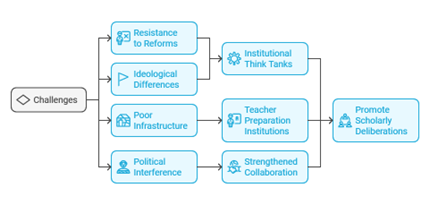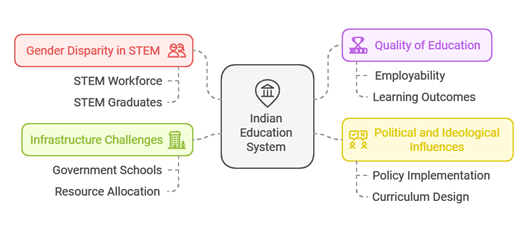THE CONTEXT: Education is central to fostering national integration and addressing socio-political divides. Educators and policymakers must rise above ideological affiliations to ensure equitable education access, quality, and inclusivity. Amartya Sen’s Capability Approach advocates for education to enhance individual freedoms and capabilities, contributing to inclusive development.
EDUCATION POLICIES IN INDIA:
-
- Kothari Commission (1964-66): The recommendations laid the foundation for the first National Education Policy (NEP) in 1968, which sought to make science and mathematics compulsory for all students up to the secondary level, a significant step toward gender equity in education. The three-language formula was introduced to promote multilingualism and national integration. Free and compulsory education for children aged 6 to 14 years was also introduced, in alignment with the Directive Principles of State Policy under Article 45 of the Indian Constitution.
- National Education Policy (1968): Universal access to primary education and expansion of secondary education. Promotion of regional languages along with Hindi and English via the three-language formula. Emphasis on science and technology education to foster a scientific temper. Vocationalization of education to bridge the gap between academics and employability.
- National Policy on Education (1986): Focus on removing gender, caste, and regional disparities through initiatives like scholarships and incentives for disadvantaged groups (e.g., Scheduled Castes, Scheduled Tribes). Introduce “Operation Blackboard” to improve infrastructure in primary schools. Expand open universities like IGNOU to promote distance learning. Promote adult literacy programs and rural universities inspired by Gandhian philosophy.
- Modified Policy (1992): Under Prime Minister P.V. Narasimha Rao, this revision emphasized privatization, decentralization, and quality enhancement in higher education.
- National Education Policy (2020): Shift from the traditional 10+2 system to a new 5+3+3+4 structure, aligning with global standards for early childhood care and education (ECCE)—integrating vocational education from Grade 6 onward with hands-on training opportunities. Focus on multidisciplinary learning by removing rigid separations between arts, sciences, curricular, co-curricular, and vocational streams—promote multilingualism with mother tongue/local language as a medium of instruction up to Grade 5.
COMPARATIVE ANALYSIS:
| POLICY | KEY FOCUS AREAS | CHALLENGES ADDRESSED | LEGACY/IMPACT |
| NEP (1968) | Equal opportunities,science & tech emphasis | Regional disparities | Foundation for modern Indian education |
| NEP (1986/1992) | Disparity removal, adult literacy | Gender/caste gaps | Operation Blackboard; rural university model |
| NEP (2020) | Skill development, digital integration | Global competitiveness; employability gap | Holistic & multidisciplinary learning |
KEY ISSUES IN INDIAN EDUCATION:
-
- Gender Disparity in STEM Education: Women constitute only 27% of the STEM workforce in India despite making up 43% of STEM graduates (World Bank, 2023). This points to a “leak in the pipeline” where women drop out of STEM careers due to systemic biases, societal pressures, and lack of support structures.
- Quality of Education and Skill Acquisition: Only 51.25% of Indian graduates are employable, reflecting a mismatch between education and industry requirements (India Skills Report, 2024). Learning outcomes remain poor; for instance, only 42% of rural students in Grade V can read Grade II-level material, as per the Annual Status of Education Report (ASER).
- Increasing Negativity and Mutual Distrust in Public Life: Rising communal tensions and ideological divides affect the inclusivity of educational institutions. Misinformation and echo chambers hinder critical thinking and informed decision-making among youth.
- Callousness of Intellectuals: Mahatma Gandhi identified the “callousness of intellectuals” as a significant societal issue, criticizing their detachment from grassroots realities. Intellectuals often focus on personal achievements rather than addressing critical social problems like poverty, inequality, or environmental degradation.
- Gap Between Policy Formulation and Implementation: Bureaucratic inefficiencies, inadequate funding, and lack of political will hinder the effective execution of educational policies. Resistance from states with differing political ideologies affects the implementation of NEP 2020.
CHALLENGES IN INDIAN EDUCATION:
-
- Resistance to Progressive Educational Reforms: The shift toward experiential and multidisciplinary learning under NEP 2020 has been slow due to the rigidity of existing curricula and examination systems. Many teachers resist reforms due to inadequate training, fear of increased workload, and lack of incentives.
- Ideological Differences: Political interference in curriculum design can lead to biases in historical narratives and cultural representation, undermining inclusivity. For instance, debates over textbook revisions have often reflected ideological agendas rather than academic rigor.
- Dilapidated Infrastructure in Government Schools: Poor infrastructure leads to overcrowded classrooms, reduced teacher-student interaction, and limited access to learning resources. Despite allocating ₹73,498 crore for school education in FY 2024-25 (highest ever), utilization remains suboptimal due to bureaucratic inefficiencies.
- Political Interference in Education Policy Implementation: Appointment of administrative heads based on political affiliations rather than merit (e.g., Vice-Chancellors, Principals). Manipulation in granting approvals for institutions or affiliations as reported by the T.S. Subramanian Committee. Curriculum revisions are influenced by ideological agendas rather than academic needs (e.g., removal of chapters on Mughal history).
THE WAY FORWARD:
-
- Creating Institutional Think Tanks with Open Boundaries: Establish Research and Development Cells (RDCs) in universities as mandated by UGC guidelines (2022) to foster innovation and interdisciplinary research. Encourage partnerships between academic institutions, industry, and civil society to address real-world problems. The success of incubation centers under NEP 2020 highlights how academia-industry linkages can drive innovation.
- Promoting Healthy Academic and Scholarly Deliberations: Organize regular Faculty Development Programs (FDPs) to enhance educators’ capacity for critical engagement with policy issues. Promote interdisciplinary conferences and symposiums on emerging themes like Industry 4.0, green education, and STEAM learning.
- Focusing on Teacher Preparation Institutions: Establish dedicated centers for teacher training at district levels to ensure last-mile access to capacity-building programs. Integrate experiential learning modules into teacher training curricula to prepare educators for real-world classroom scenarios.
- Encouraging Holistic Thinking and Long-Term Vision Among Educators: Promote lifelong learning among educators by integrating continuous professional development into their career trajectories. Encourage educators to adopt a long-term vision aligned with national goals like achieving a Gross Enrollment Ratio (GER) of 50% in higher education by 2035, as envisioned in NEP 2020.
- Strengthening the Consultation and Collaboration System: Institutionalize mechanisms like joint task forces comprising representatives from central and state governments to oversee policy execution. Use platforms like NITI Aayog for structured consultations involving all stakeholders, including academia, industry, and civil society. The National Knowledge Commission (2005) successfully brought together diverse stakeholders to propose reform that shaped higher education policies during the Eleventh Five-Year Plan.

THE CONCLUSION:
The education system in India requires effective implementation of NEP 2020 through collaboration between central and state governments, robust teacher training, and equitable access to quality education, ensuring a skilled workforce to harness the demographic dividend. With over 50% of India’s population under 25 and a projected GER target of 50% by 2035, prioritizing inclusivity, innovation, and infrastructure is critical for sustainable national development.
UPSC PAST YEAR QUESTION:
Q.1 The Right of Children to Free and Compulsory Education Act, 2009, remains inadequate in promoting an incentive-based system for children’s education without generating awareness about the importance of schooling. Analyse. 2022
Q.2 National Education Policy 2020 conforms with the Sustainable Development Goal-4 (2030). It intends to restructure and reorient the education system in India. Critically examine the statement. 2020
MAINS PRACTICE QUESTION:
Q.1 “The destiny of India is being shaped in its classrooms.” In light of this statement, critically analyze the evolution of education policies in post-independence India, focusing on the National Education Policy 2020.
SOURCE:
https://www.dailypioneer.com/2024/columnists/education–from-kothari-commission-to-nep-2020.html
Spread the Word

